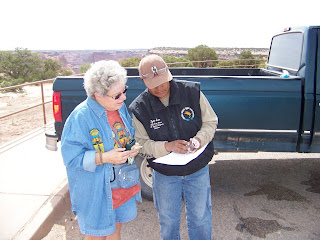Canyon de Chelly (pronounced d'SHAY) is located near Chinle, Az, in the northeast corner of the state. It has been a National Monument, but has recently been named a National Park. According to the park brochure, the canyon "embraces a past of more than 200 million years of geologic history and 2000 years of human history."
The oldest ruins are believed to have be constructed 2000 years ago by the Anasazi (ancient Puebloan people). Many years later they were followed by the Hopi Indians. About 200 years after the Anasazi people migrated, the Navajo Indians first inhabited the canyon. Nobody knows why the earlier groups of people moved on or disappeared, but the canyon is now on the Navajo Indian Reservation which is over 17 million acres.
For many years, Navajo families lived in the canyon, farming and raising animals. Now, nobody lives in the canyon all year, but some people still live there and farm during the summer. The land in the canyon itself has been handed down for as many as 100 generations.
Alan took a guided tour of the canyon floor - you cannot enter the canyon itself without a Navajo guide. The next day, we went to the overlooks on both the south and north rims. These pictures don't begin to do it justice. The beautiful, red sandstone walls just don't show up in pictures as vivid as they are.
This is our "we were there" picture.
These next pictures didn't exactly load in the right order, but it is late so I am just going to go with it.
Rock art - most in the canyon are pictographs (painted) and were done many years ago.
There are also some petroglyphs (carved into the walls). There is no real way to tell, but some experts have theories about what they mean.
The dark stains on the canyon wall, called desert varnish, come from water running down the walls, causing a chemical reaction that deposits manganese in dark streaks. The petroglyphs carved away the dark part, exposing the light rock underneath.
The walls here are about 1000 feet high.
The upper ruins here are about 2000 years old, with the lower ones about 1000 years old.
Many areas have rocks that look like layer upon layer of fine pastry. I wish the pictures showed this better because it was amazing to see.
An example of a farm on the canyon floor. There is a small house or structure at the bottom with fields above it. What looks like a road is actually the river bed. It is dry now except at times of rain or during the monsoon season.
This is Sandy with Darlene Sam, a Navajo Indian who grew up in the canyon. We bought a small handmade pot from her that tells the story of her family. She is explaining the various designs on the pot. There is a spirit line, kind of a broken line, that goes from bottom to top, allowing the bad spirits out and the good spirits in.
We saw quite a few rental RVs and thought this one with the dog painted in the window of the door was really fun.
Karen, this is to show you that little lizards like the ones in your yard also live here.
























No comments:
Post a Comment